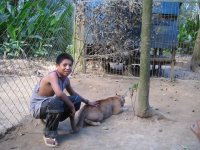Thursday, June 22, 2006
Samaipata & The Chiquitos Jesuit Missions
Gods, myths & idols
[Pictures to follow when I can get to an USB port]
Once rested in Santa Cruz after the parque experience, we headed a little way south via crazy Bolivian converted Toyota taxi (again stuffed with passengers and puffed corn products) to Samaipata, location of a pre-columbian religious centre, perched atop a near by peak. And not far is Villegrande where Che spent 30 years buried under the airstrip, after his rather pitiful attempt to stir Bolivia to revolution. I remember his Bolivian Diaries reading more like "Carry On Che" so I didn´t feel it necessary to visit the sites of his demise (although I now think Che´s descriptive skills must be pretty good, as the countryside was very much as I imagined). Having completed something of a Che trail of my own accidental making, my recommendation to Che fans of a far more worthwhile pilgrimage, I think, would be to his childhood home in Alta Gracia in Cordoba, Argentina, where there is an excellent museum.
Missions Impractical:
It was then onto another Jesuit mission circuit: the Chiquitos missions in Santa Cruz region, and as if to wet the appetite by some kind of divine intervention The Mission had been on TV in Santa Cruz the week before! (And although I´d forgoten what a fantastic actor Ray McAnally was, turgid Jeremy Irons sent me to sleep before De Niro´s splashdown finale). However, the actual missions are an absolute bugger to get to, and I was left wondering whether it was worth it, with the long drawn out journies and relatively small amount of interest to see. The worst of the circuit´s towns is the last, San Jose, with oppressive heat that shuts the town up for most of the day, and dire hotels... and we got stuck there for 3 tedious days, thanks to the vagueries of the "Death Train", our exit route from the circuit. The first day it didn´t run; the second it stopped down the line from the station so we missed it (apparently we should have known that it stopped there because the there was a sign on the station apologising for the inconvenience due to the building work...it just didn´t mention what the inconvenience was... oh well); and on the third day a train derailed somewhere down the line. We finally got a slow train out at 2am the following morning.
I think these last few days may well have jaded my view, and certainly the missions, San Miguel and Santa Ana particularly, are tranquil, beautiful places. And in each we were lucky to enough to get a little more than expected to our visit: services, choral and violin practices and the like.
When two worlds collide:
Throughout this part of the Bolivia there are Mennonite communities and these uniformly dressed, conservative anabaptists are in and out of the towns, although they do seem to be a fairly insular bunch... I´ve got to admit there does seem to be some evidence of over crouding in the gene pool, and on occassion I found myself inadvertedly humming the "Dueling Banjos". However, the Menonnite man we met on the bus to San Jose was a great guy, if a little short on the whole sphere of reference thing: he´d lived in Bolivia for 31 years but didn´t speak much better Spanish than us, and hadn´t heard of Lake Titicaca. And we did have one of those "is it our use of language or the worlds we live in?" moments when Norwegian Chris was talking to him about what farming there was in Norway: she told him that her aunt worked with horses and the Mennonite guy asked "Oh, so she doesn´t have a tractor?" Nor do they appear to be without humour: one fella had a Tommy Hilfiger label stitched on to his overalls... I´m pretty certain Hilfiger hasn´t entered the Mennonite market yet.
Giant parrot news: I was delighted to discover that the giant bird phone boxes weren´t just in Camiri but all over the region, but best of all are the rampant jaguar ones to be found in San Ramon and San Ignacio.
Overheard in the street: Everytime you say that I think you´re saying "I´m just going to see if I can use their banjo".
If you´re ever in Santa Cruz: Give it a chance. It looks like an utter sh*thole arriving at the "bimodel" bus and train station, but the centre of town is great. Not yet in the guide books is Lorca, just by the Cathedral, a great cafe/bar/arts centre. And if you do get stuck at the dark and gloomy bimodal, try the cafes upstairs, they were staffed by really friendly people serving cheap good food when we were there; an the public toilets are fine (you even get a ticket for your Bol$1!)
Dispelling the myths:
So many travellers you bump into along the way tell you about the dreadful things that have heard have happend to someone they have met whilst travelling in Bolivia. I am pleased to say that throughout this side of the country we were the victims of no crime, had only very good experiences with the Bolivian authorities, and despite eating from marketstalls, roadside stalls, vendors on buses and trains, and a fair few back yard restaurants, suffered no sign of a dickie tummies (I put this down to clean hands, lemon juice and lots of hot sauce). I hope this will be our experience when we return to Bolivia in a few weeks time. But for now, it´s off into the depths of the Brazilian Pantanal, but I´m already looking forward to coming back to this beautiful country, with its wonderful people and exciting continued social changes.
Monday, June 12, 2006
Parque Ambue Ari
Extreme sports covering as conservation
 Over the last couple of weeks I had to keep reminding myself that the animals, birds and children at this animal sanctuary in the Bolivian jungle were better off than they otherwise would have been, and that very few people are doing any kind of conservation here. But I also felt that I was somehow being disloyal to my own principles, and honestly couldn´t wait to leave. Within the first day I felt the park was chaotic and wastefully disorganised, in the next few I decided the people running the park were misguided even if their hearts were in the right place, but by the end of my stay I was doubting even that. I refuse to accept the patronising "but it´s Bolivia" excuse that other people in the camp gave: widespread poverty and bad infrastructure may be huge disadvantages, but if anything it´s made the Bolivians a hugely ingenious and resourceful people.
Over the last couple of weeks I had to keep reminding myself that the animals, birds and children at this animal sanctuary in the Bolivian jungle were better off than they otherwise would have been, and that very few people are doing any kind of conservation here. But I also felt that I was somehow being disloyal to my own principles, and honestly couldn´t wait to leave. Within the first day I felt the park was chaotic and wastefully disorganised, in the next few I decided the people running the park were misguided even if their hearts were in the right place, but by the end of my stay I was doubting even that. I refuse to accept the patronising "but it´s Bolivia" excuse that other people in the camp gave: widespread poverty and bad infrastructure may be huge disadvantages, but if anything it´s made the Bolivians a hugely ingenious and resourceful people.
Bolita - dig your own hole
 I stayed only because I had made a promise to myself I would complete building a house for Bolita, an utterly enchanting baby Giant Anteater. But this was more because I simply could not stand that a 10 year old boy continue sharing a bed with her. This is an example of contradictory and strange situations that the park allows. They treat most of the animals as pets initially, while deciding how they should be re-introduced to the wild if they can: for Junior, one baby howler monkey, having spent months sleeping in the volunteers beds, it was determined he should no longer do so, and so he was forced into a cage barely bigger than himself at nights, until a gang of us quickly built a new home for him. One other wild monkey that had been encouraged to visit was attacked and killed by a wild cat who is also encouraged to visit. Iggy, a depressed but other wise well iguana, had his leg broken whilst in the park's care by a racoon type animal. And on the day I left they were off bringing 3 ocelots and a puma back from Santa Cruz...wait for it... apparently by bus!
I stayed only because I had made a promise to myself I would complete building a house for Bolita, an utterly enchanting baby Giant Anteater. But this was more because I simply could not stand that a 10 year old boy continue sharing a bed with her. This is an example of contradictory and strange situations that the park allows. They treat most of the animals as pets initially, while deciding how they should be re-introduced to the wild if they can: for Junior, one baby howler monkey, having spent months sleeping in the volunteers beds, it was determined he should no longer do so, and so he was forced into a cage barely bigger than himself at nights, until a gang of us quickly built a new home for him. One other wild monkey that had been encouraged to visit was attacked and killed by a wild cat who is also encouraged to visit. Iggy, a depressed but other wise well iguana, had his leg broken whilst in the park's care by a racoon type animal. And on the day I left they were off bringing 3 ocelots and a puma back from Santa Cruz...wait for it... apparently by bus!
But perhaps the most ridiculous situation is that volunteers, with no supervision or experience, are allowed to walk (yep, animals on leads like dogs) jaguars and pumas. It's just a serious accident waiting to happen: bites and scratches are a daily occurrence and serious wounds regular. And I can't believe it's great for the animals' well being either. Unfortunately it also means some f**kwits actually encourage the cats to jump them, so they can get trophy scars. Something tells me giving big cats a taste for attacking humans might backfire at some point...
 The conditions in the camp were fairly dreadful with showers and toilets sub music festival standards. There is no science taking place and plans for the animals are, at best, fluffy. I heard they are starting to build "luxuary" cabañas for day trippers, which will turn the place into little more than a zoo. I'm sure that improved conditions for (paying) volunteers and developing a serious programme would encourage most volunteers to stay longer, and pay more.
The conditions in the camp were fairly dreadful with showers and toilets sub music festival standards. There is no science taking place and plans for the animals are, at best, fluffy. I heard they are starting to build "luxuary" cabañas for day trippers, which will turn the place into little more than a zoo. I'm sure that improved conditions for (paying) volunteers and developing a serious programme would encourage most volunteers to stay longer, and pay more.
Bored Free
 On a lighter side, there are some things that you´re never quite sure how you´re going to tell your mother, but when I arrived I was told I would help look after a puma called Elsa. The cat was on heat, she mewed when I called her name, followed me around, took no interest in the two women who I was working with, and I spent most of a week rubbing her hind quarters, ...yes mum, your son went to South America and got a job pleasuring a big cat. Elsa, a pet from being a cub, has apparently always disliked being walked and after some kind of "incident" a year ago has not left her cage. But while she was in a man-loving mood it meant she was safely approachable in her cage to the point that she would nuzzle my face.
On a lighter side, there are some things that you´re never quite sure how you´re going to tell your mother, but when I arrived I was told I would help look after a puma called Elsa. The cat was on heat, she mewed when I called her name, followed me around, took no interest in the two women who I was working with, and I spent most of a week rubbing her hind quarters, ...yes mum, your son went to South America and got a job pleasuring a big cat. Elsa, a pet from being a cub, has apparently always disliked being walked and after some kind of "incident" a year ago has not left her cage. But while she was in a man-loving mood it meant she was safely approachable in her cage to the point that she would nuzzle my face.
Juan Carlito's Way
 Every now and then I'd have to stop and think: Barney, you're in the middle of the Bolivian jungle with puma... and you're being bossed around by Juan Carlos, a 15 year old. Juan Carlito is a great kid, full of ideas (some of them rubbish by the way), who wants to be a vet. He also had a healthy fear of the jungle, a few of us took turns to walk him the 1km to his cabaña at night after he got a bit worried about doing the trip alone having seen a wild jaguar one night... can you blame him? Quite frankly what I would have done if the cat had turned up again I don't know, but I'm not sure trying to blind it with the faint glow of my maglite would have done the trick.
Every now and then I'd have to stop and think: Barney, you're in the middle of the Bolivian jungle with puma... and you're being bossed around by Juan Carlos, a 15 year old. Juan Carlito is a great kid, full of ideas (some of them rubbish by the way), who wants to be a vet. He also had a healthy fear of the jungle, a few of us took turns to walk him the 1km to his cabaña at night after he got a bit worried about doing the trip alone having seen a wild jaguar one night... can you blame him? Quite frankly what I would have done if the cat had turned up again I don't know, but I'm not sure trying to blind it with the faint glow of my maglite would have done the trick.
With Bolita´s house built and occupied, I have retreated to Santa Cruz for a hot shower, decent food and comfortable bed... shear luxuary.
 Over the last couple of weeks I had to keep reminding myself that the animals, birds and children at this animal sanctuary in the Bolivian jungle were better off than they otherwise would have been, and that very few people are doing any kind of conservation here. But I also felt that I was somehow being disloyal to my own principles, and honestly couldn´t wait to leave. Within the first day I felt the park was chaotic and wastefully disorganised, in the next few I decided the people running the park were misguided even if their hearts were in the right place, but by the end of my stay I was doubting even that. I refuse to accept the patronising "but it´s Bolivia" excuse that other people in the camp gave: widespread poverty and bad infrastructure may be huge disadvantages, but if anything it´s made the Bolivians a hugely ingenious and resourceful people.
Over the last couple of weeks I had to keep reminding myself that the animals, birds and children at this animal sanctuary in the Bolivian jungle were better off than they otherwise would have been, and that very few people are doing any kind of conservation here. But I also felt that I was somehow being disloyal to my own principles, and honestly couldn´t wait to leave. Within the first day I felt the park was chaotic and wastefully disorganised, in the next few I decided the people running the park were misguided even if their hearts were in the right place, but by the end of my stay I was doubting even that. I refuse to accept the patronising "but it´s Bolivia" excuse that other people in the camp gave: widespread poverty and bad infrastructure may be huge disadvantages, but if anything it´s made the Bolivians a hugely ingenious and resourceful people.Bolita - dig your own hole
 I stayed only because I had made a promise to myself I would complete building a house for Bolita, an utterly enchanting baby Giant Anteater. But this was more because I simply could not stand that a 10 year old boy continue sharing a bed with her. This is an example of contradictory and strange situations that the park allows. They treat most of the animals as pets initially, while deciding how they should be re-introduced to the wild if they can: for Junior, one baby howler monkey, having spent months sleeping in the volunteers beds, it was determined he should no longer do so, and so he was forced into a cage barely bigger than himself at nights, until a gang of us quickly built a new home for him. One other wild monkey that had been encouraged to visit was attacked and killed by a wild cat who is also encouraged to visit. Iggy, a depressed but other wise well iguana, had his leg broken whilst in the park's care by a racoon type animal. And on the day I left they were off bringing 3 ocelots and a puma back from Santa Cruz...wait for it... apparently by bus!
I stayed only because I had made a promise to myself I would complete building a house for Bolita, an utterly enchanting baby Giant Anteater. But this was more because I simply could not stand that a 10 year old boy continue sharing a bed with her. This is an example of contradictory and strange situations that the park allows. They treat most of the animals as pets initially, while deciding how they should be re-introduced to the wild if they can: for Junior, one baby howler monkey, having spent months sleeping in the volunteers beds, it was determined he should no longer do so, and so he was forced into a cage barely bigger than himself at nights, until a gang of us quickly built a new home for him. One other wild monkey that had been encouraged to visit was attacked and killed by a wild cat who is also encouraged to visit. Iggy, a depressed but other wise well iguana, had his leg broken whilst in the park's care by a racoon type animal. And on the day I left they were off bringing 3 ocelots and a puma back from Santa Cruz...wait for it... apparently by bus!But perhaps the most ridiculous situation is that volunteers, with no supervision or experience, are allowed to walk (yep, animals on leads like dogs) jaguars and pumas. It's just a serious accident waiting to happen: bites and scratches are a daily occurrence and serious wounds regular. And I can't believe it's great for the animals' well being either. Unfortunately it also means some f**kwits actually encourage the cats to jump them, so they can get trophy scars. Something tells me giving big cats a taste for attacking humans might backfire at some point...
 The conditions in the camp were fairly dreadful with showers and toilets sub music festival standards. There is no science taking place and plans for the animals are, at best, fluffy. I heard they are starting to build "luxuary" cabañas for day trippers, which will turn the place into little more than a zoo. I'm sure that improved conditions for (paying) volunteers and developing a serious programme would encourage most volunteers to stay longer, and pay more.
The conditions in the camp were fairly dreadful with showers and toilets sub music festival standards. There is no science taking place and plans for the animals are, at best, fluffy. I heard they are starting to build "luxuary" cabañas for day trippers, which will turn the place into little more than a zoo. I'm sure that improved conditions for (paying) volunteers and developing a serious programme would encourage most volunteers to stay longer, and pay more.Bored Free
 On a lighter side, there are some things that you´re never quite sure how you´re going to tell your mother, but when I arrived I was told I would help look after a puma called Elsa. The cat was on heat, she mewed when I called her name, followed me around, took no interest in the two women who I was working with, and I spent most of a week rubbing her hind quarters, ...yes mum, your son went to South America and got a job pleasuring a big cat. Elsa, a pet from being a cub, has apparently always disliked being walked and after some kind of "incident" a year ago has not left her cage. But while she was in a man-loving mood it meant she was safely approachable in her cage to the point that she would nuzzle my face.
On a lighter side, there are some things that you´re never quite sure how you´re going to tell your mother, but when I arrived I was told I would help look after a puma called Elsa. The cat was on heat, she mewed when I called her name, followed me around, took no interest in the two women who I was working with, and I spent most of a week rubbing her hind quarters, ...yes mum, your son went to South America and got a job pleasuring a big cat. Elsa, a pet from being a cub, has apparently always disliked being walked and after some kind of "incident" a year ago has not left her cage. But while she was in a man-loving mood it meant she was safely approachable in her cage to the point that she would nuzzle my face.Juan Carlito's Way
 Every now and then I'd have to stop and think: Barney, you're in the middle of the Bolivian jungle with puma... and you're being bossed around by Juan Carlos, a 15 year old. Juan Carlito is a great kid, full of ideas (some of them rubbish by the way), who wants to be a vet. He also had a healthy fear of the jungle, a few of us took turns to walk him the 1km to his cabaña at night after he got a bit worried about doing the trip alone having seen a wild jaguar one night... can you blame him? Quite frankly what I would have done if the cat had turned up again I don't know, but I'm not sure trying to blind it with the faint glow of my maglite would have done the trick.
Every now and then I'd have to stop and think: Barney, you're in the middle of the Bolivian jungle with puma... and you're being bossed around by Juan Carlos, a 15 year old. Juan Carlito is a great kid, full of ideas (some of them rubbish by the way), who wants to be a vet. He also had a healthy fear of the jungle, a few of us took turns to walk him the 1km to his cabaña at night after he got a bit worried about doing the trip alone having seen a wild jaguar one night... can you blame him? Quite frankly what I would have done if the cat had turned up again I don't know, but I'm not sure trying to blind it with the faint glow of my maglite would have done the trick.With Bolita´s house built and occupied, I have retreated to Santa Cruz for a hot shower, decent food and comfortable bed... shear luxuary.